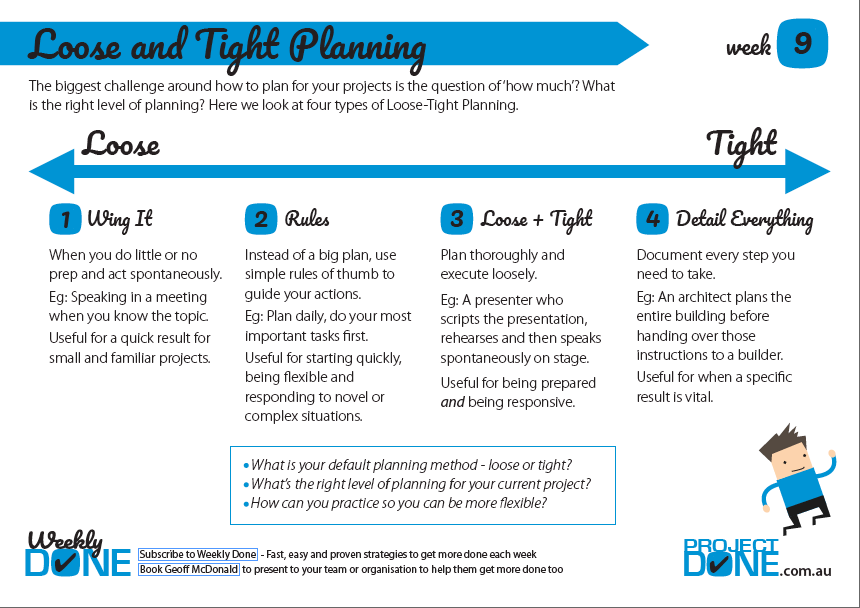
What is Planning in Management?
Planning in management is a crucial part of how to take effective action. But what is it and how do we do it well?
Planning is such a common word, but what specifically do we mean when we say ‘we are going to do some planning’?
The word ‘plan’ is a heteronym, which means it can be both a verb (action/doing word) and a noun (a thing).
When we speak about the action of planning we often speak about the ordering of things. The plan becomes a description of the final organisation or arrangement.
As a former architect, I have a lot of experience in planning and design. I tend to think we can add three other elements to this definition:
- Planning solves a problem – generally, how to get from our current situation to a better future one.
- To plan is to make decisions. You are eliminating a lot of options and including or making others a priority.
- The ideal order is to plan and then act. The big advantage is that we can think through our options before we take action.
The Goldilocks Planning Principle
Do you remember the story of Goldilocks and the Three Bears? In case you don’t, it goes something like this…
A little blonde girl is wandering around in the forest. What she is doing there on her own I don’t know… Anyway, she stumbles across a small cottage and decides to break in.
When she steps inside everything is in sets of three. Weird?
There is a big chair, a little chair and one in between.
The lazy homeowners didn’t clean up their breakfast and on the table are three half-eaten bowls of porridge. Our blonde girl decides to sample their food. One bowl is too hot, one is too cold and the other is just right.
After eating too much porridge she feels tired – eating too many carbs will do that to you. She wanders into the bedroom and there are… wait for it… yep, you guessed it, there are three beds. After playing trampolines on the beds she realises that one bed is too hard, one is too soft and the other is just right.
She falls asleep and when the homeowners return they are a little grizzly… sic.
I’m guessing they call the police who take her away never to be seen again. Or something like that…
Like Goldilocks, we can plan too much, too little or just right. And this will be different for everyone. For your projects, do you like to plan a lot or a little?
The Four Types of Planning in Management
The biggest challenge around how to plan for your projects is the question of ‘how much’? What is the right type of planning? Too little planning could cost us missing our goal. Too much planning can be a waste of our time, money and energy.
Here are four types of planning ranging from loose to tight.
1 Wing It
The term ‘wing it’ comes from the theatre. When an actor forgot what to say they were thrown a line by someone standing on the sides or the wings of the stage.
Today we use this term to refer to action we take with little or no preparation. It’s often acting spontaneously.
For example, if you know your topic really well and were speaking in a meeting no prep is needed, just let ‘er rip!
This is useful if you want a quick result for small and familiar projects or situations. Just don’t apply this to planning your projects.
2 Rules
Often we waste time, energy and attention by making a big fat plan when we really don’t need that level of detail.
Instead, we can start really quickly by creating and using some simple rules of thumb.
For example, when you plan your day you probably don’t need to design everything including your bathroom breaks. That’s overkill. Instead, if we just said ‘do the most important task first’ we can look at our list of tasks, pick one and start in about the time it takes Usain Bolt to run 100 metres. (BTW – that’s just under 10 seconds)
This is useful for starting work quickly plus it allows us to be flexible and respond to novel or complex situations.

A really fantastic book on creating rules for work is Simple Rules by Donald Sull and Kathleen Eisenhardt. I rapped this book over at Book Rapper as Rules Rule and included it in our Get More Done Bundle. Plus, I devoted an entire chapter to it as one of my Seven Rules of Done in my book Done.
3 Loose AND Tight
This might sound like a paradox – how do you do both loose AND tight?
It is possible – plan thoroughly AND execute loosely.
For example, a presenter might script their presentation, rehearse it thoroughly and then speak it spontaneously on stage.
Alternatively, footballers practice very specific drills in training so they can react to the chaos of an actual game without having to think about all of the little details.
This is really useful for being well prepared ANDbeing responsive to whatever situation you might find yourself in.
4 Detail Everything
To detail everything is where you spend a lot of time documenting every step you need to take before you take action.
I was trained in this approach in my first career as an architect. Given buildings are complex to design and mistakes are costly; it’s a good reason to plan the entire building before handing over those instructions to the builder.
This is useful for when it’s critical you get it right and a specific result is vital.

Planning in Management
The big challenge around planning in management is the type of planning that is required.
Traditional planning tended to focus on Level 4 Detail Everything. This was a default move partly driven by a desire to be able to justify decision-making and execution to our bosses and managers.
The problem with this approach (particularly in more recent years) is that the extended time is taken to scope the project to secure the funding and approval often meant that the conditions would change before the work commences.
This happened a lot with software projects as the technology of software design and computer technology was often moving faster than the project team could scope the work. This is why the Agile and Scrum movements have transformed how to plan and implement projects and forced a shift away from the Detail Everything type of planning.
What’s your Planning Preference?
We all have preferences. Some prefer red wine, others white. Some prefer blondes, others brunettes. Some prefer to plan loosely, others tightly. Generally, the more flexible we can be the better we can tune into what is needed in the situation that sits in front of them.
Five questions to find your Planning Preference:
- Which way of planning do you prefer: loose or tight?
- How is that working out for you?
- Does it work better in some situations and not others?
- What’s the right type of planning for your current project?
- How can you practice so you can be more flexible across all four types of planning?
As I mentioned, my first career was as an architect. For a decade I was trained in Detail Everything. Now, I’m much more fluent in all four modes. For my projects, I now prefer several simple rules. When I present I know I can wing it if I have to stand up and speak to a group instantly. However, I do prefer to do loose and tight – plan tightly and then throw away the script so I can be present and aware of the audience in front of me and not in my head trying to remember what I was going to say next.
Summary: The Four Types of Planning in Management
There are many different levels and types of planning that we can take. While we all have a default or a preference, the more flexible we can be in our choices, the better chance we can answer the age-old problem of deciding how much time, effort and energy to spend planning before we start taking action.



